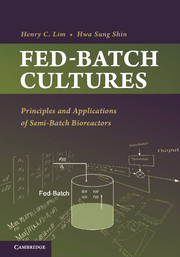Book contents
- Frontmatter
- Contents
- Preface
- Acknowledgments
- 1 Introduction to Fed-Batch Cultures
- 2 Idealized Reactors and Fed-Batch Reactors
- 3 Maximization of Reaction Rates and Fed-Batch Operation
- 4 Phenomena That Favor Fed-Batch Operations
- 5 Classification and Characteristics of Fed-Batch Cultures
- 6 Models Based on Mass Balance Equations
- 7 Non–Equation-Based Models
- 8 Specific Rate Determination
- 9 Optimization by Pontryagin's Maximum Principle
- 10 Computational Techniques
- 11 Optimization of Single and Multiple Reactions
- 12 Optimization for Cell Mass Production
- 13 Optimization for Metabolite Production
- 14 Simple Adaptive Optimization
- 15 Measurements, Estimation, and Control
- 16 Feasibility Assessment and Implementable Feed Rates
- Index
- References
15 - Measurements, Estimation, and Control
Published online by Cambridge University Press: 05 April 2013
- Frontmatter
- Contents
- Preface
- Acknowledgments
- 1 Introduction to Fed-Batch Cultures
- 2 Idealized Reactors and Fed-Batch Reactors
- 3 Maximization of Reaction Rates and Fed-Batch Operation
- 4 Phenomena That Favor Fed-Batch Operations
- 5 Classification and Characteristics of Fed-Batch Cultures
- 6 Models Based on Mass Balance Equations
- 7 Non–Equation-Based Models
- 8 Specific Rate Determination
- 9 Optimization by Pontryagin's Maximum Principle
- 10 Computational Techniques
- 11 Optimization of Single and Multiple Reactions
- 12 Optimization for Cell Mass Production
- 13 Optimization for Metabolite Production
- 14 Simple Adaptive Optimization
- 15 Measurements, Estimation, and Control
- 16 Feasibility Assessment and Implementable Feed Rates
- Index
- References
Summary
To optimize bioreactor operations and to operate them effectively, it is essential to be able to monitor and control the bioreactor operating conditions. It is most desirable to have reliable in situ, on-line sensors and measurement devices that can supply measurements of various variables and parameters without a significant time delay so that the information provided by these devices can be used to implement optimization strategies to improve the productivity and efficiency of processes. These devices can be broadly classified as in situ, on-line, and off-line.
This on-line data acquisition would allow on-line optimization and control of bioreactors. For the purposes of process optimization and control, it is desirable to have reliable in situ sensors with a short response time, and because they come into direct contact with the culture medium, they must withstand the sterilization process. When it is not possible to sterilize the sensors, on-line measurement via sampling of the culture medium or culture gas stream can be utilized. Thus, shorter sampling lines that can maintain sterility are required for the liquid and gas sample lines.
- Type
- Chapter
- Information
- Fed-Batch CulturesPrinciples and Applications of Semi-Batch Bioreactors, pp. 407 - 436Publisher: Cambridge University PressPrint publication year: 2013



